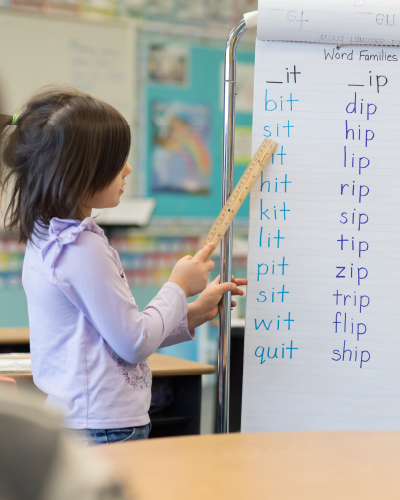The Colorado Department of Education's main phone line (303-866-6600) will be closed on Friday, February 7 from 8am until 1pm.
Lines will re-open at 1pm. For immediate assistance, contact cde_communications_office@cde.state.co.us.
You are here
PRINT VERSION
READ Online Teacher Training Facilitator Guide
READ Online Teacher Training Facilitator Guide


Overview
The CDE Facilitator Guide for Building a Strong Foundation: Developing Early Literacy Skills is designed to support school leaders in implementing the learning into practice in their school context. The facilitator guide offers flexible options for reviewing key course concepts, analyzing school curriculum and student data, and implementing evidence-based literacy instructional practices in all K-3 classrooms.
The Facilitator Guide is broken down by content modules correlated with the Building a Strong Foundation course progression: Developing Early Literacy Skills online teacher training. Each content module contains approximately 8 hours of online coursework, and the guide is intended to support professional development following the completion of the online module. However, professional learning activities are flexible and may be distributed over time, depending on the time available to a group or school. The guide is created as a “menu” to allow the facilitator to select options that best meet the needs of their school context.
Get Started!
4. Complete the Course & Each Module Guide
Learn How to Use the Module Guides
Each module guide is designed to provide a predictable sequence of learning opportunities throughout the training and implementation.
Module Objectives
First, the module’s objectives are listed to give an overview of the expected outcomes following completion of the module.
Teachers Do
Next, the “Teachers Do” column provides information related to the Module Overview and the Resource Library.
The Resource Library for each module provides facilitators access to the course content teachers will be completing. A separate column for facilitators contains curated research titles, articles, resources and video clips from the training to ensure ease of access and messaging alignment for the key concepts in the module.
Action Plan
Finally, the action plan for facilitated sessions is broken down into three components: Review, Reflect/Analyze and Implementation.
Review
The Review section of the Facilitator Guide is designed to provide teachers an opportunity to discuss their learning, clear up misconceptions, and solidify their understanding of the key concepts in the module. Each ‘review’ section includes essential questions that can be utilized in group discussions, reflective journaling, or other engagement protocols. The review section contains options for activities that engage teachers in the concepts and instructional practices introduced in training. These activities are linked in the ‘Activities Guide’ and include time, materials, and descriptions that allow for easy facilitation. All activities are presented as “options” so facilitators can decide what is most beneficial for their staff.
Reflect/Analyze
The Reflect/Analyze section of the Facilitator Guide progresses from reviewing the content learning to reflecting on resources and analyzing student-level data. This section provides tools for looking critically at school curriculum and how it aligns to scientifically and evidence-based literacy instruction as well as templates for analyzing individual student data through each component of literacy. Again, this section is designed to be used flexibly based on the needs of the school.
Implementation
The final component of the facilitation guide is Implementation. This section of the guide provides guidance and resources to move the concepts from the training into practice in each classroom. This section provides options for individual teacher reflection on their current practice in both overall effective instructional practices and critical “look fors” specific to the individual components of effective literacy instruction. These resources are meant to allow teachers to identify their own instructional strengths and areas for growth and provide leaders and coaches tools for observing classroom instruction and targeting areas for improvement. These tools can be used to compile critical data at the individual classroom level and the school level.
Please note that in order to access the content of this document, facilitators must have registered access to the online course online asynchronous training “Building a Strong Foundation: Developing Early Literacy Skills” by the Public Consulting Group, Inc.
Pacing Guide
Overview
The pacing schedule for the PCG online asynchronous teacher training, Building a Strong Foundation: Developing Early Literacy Skills, provides school leaders with options for pacing the training so that K-3 teachers can complete each module of learning in a timely manner. Pacing the training ensures completion to meet the requirements of the READ Act and allows local leaders to facilitate ongoing professional development and implementation schedules to ensure evidence-based instructional practices in teaching reading are effectively implemented in each K-3 classroom. The suggestions provided in this pacing guide are only examples; the options offer a picture of how coursework completion, facilitation of supportive professional development sessions, and schedules of classroom observations can cycle throughout the year to maximize effective implementation.
Questions to Consider
School leaders will want to consider many questions before introducing a pacing schedule to support the online teacher training. Consider:
-
How will teachers be asked to complete the required training hours in the asynchronous online training Building a Strong Foundation: Developing Early Literacy Skills?
- For example, will teachers be expected to complete the training independently, or will there be scheduled time to complete the training during school contract time? Will there be a combination of the two?
-
What additional components will be offered to support implementation?
- Will professional development time be included for review opportunities, reflection and planning, classroom observations, coaching?
-
What time is available for these opportunities?
- Are there multiple chunks of time available on a regular basis, such as during PLCS or weekly meetings?
- Are PD days available to spend larger amounts of time with the content? How often do these occur?
- Will opportunities occur in grade level teams, whole staff, small groups, etc?
- How does the time available impact the pacing schedule?
-
What additional initiatives will impact the time available for course completion and/or additional support?
-
What timeline is reasonable for ensuring that the learning from the training is being implemented effectively?
Pacing Options
| If you wish to complete the online training in: | Complete... | At a rate of approximately... |
|
1 module every 2 weeks |
4 hours/week |
|
|
18 weeks (1 semester) |
1 module every 3 weeks |
2.5-3 hours/week |
|
1 module/month |
2 hours/week |
Example 12 Week Course Completion
- Start Date: August 23, 2021
- Completion Date: November 14, 2021
| Module: |
Teachers complete online coursework between: |
Facilitate: |
Complete classroom observations by: |
|
Module 1 |
August 23 and September 5, 2021 |
Week of September 6, 2021 |
September 17,2021 |
|
Module 2 |
September 6 and September 19, 2021 |
Week of September 20, 2021 |
October 2, 2021 |
|
Module 3 |
September 20 and October 3, 2021 |
Week of October 4, 2021 |
October 15, 2021 |
|
Module 4 |
October 4 and October 17, 2021 |
Week of October 18, 2021 |
October 29, 2021 |
|
Module 5 |
October 18 and October 31, 2021 |
Week of November 1, 2021 |
November 12, 2021 |
|
Module 6 |
November 1 and November 14, 2021 |
Week of November 15, 2021 |
December 3, 2021* |
*Completion dates account for approximate holiday break
Example 18 Week Course Completion
- Start Date: August 23, 2021
- Completion Date: January 9, 2022
| Module: |
Teachers complete online coursework between: |
Facilitate: |
Complete classroom observations by: |
|
Module 1 |
August 23 and September 12, 2021 |
Week of September 13, 2021 |
October 1, 2021 |
|
Module 2 |
September 13 and October 3, 2021 |
Week of October 4, 2021 |
October 22, 2021 |
|
Module 3 |
October 4 and October 24, 2021 |
Week of October 25, 2021 |
November 12, 2021 |
|
Module 4 |
October 25 and November 14, 2021 |
Week of November 15, 2021 |
December 3, 2021 |
|
Module 5 |
November 15 and December 5, 2021 |
Week of December 6, 2021 |
January 7, 2022* |
|
Module 6 |
December 6 and January 9, 2022* |
Week of January 10, 2022 |
January 28, 2022 |
*Dates account for approximate holiday breaks
Example 24 Week Course Completion
- Start Date: August 30, 2021
- Completion Date: April 1, 2022
| Module: |
Teachers complete online coursework between: |
Facilitate between: |
Complete classroom observations by: |
|
Module 1 |
August 30 and September 26, 2021 |
September 27 and October 8, 2021 |
October 22, 2021 |
|
Module 2 |
September 27 and October 24, 2021 |
October 25 and November 5, 2021 |
November 27, 2021 |
|
Module 3 |
October 25 and November 28, 2021 |
November 29 and December 10, 2021 |
January 7, 2022* |
|
Module 4 |
November 29 and January 9, 2022* |
January 10 and January 21, 2022 |
February 4, 2021 |
|
Module 5 |
January 10 and February 6, 2022 |
February 7 and February 18, 2021 |
March 4, 2022 |
|
Module 6 |
February 7 and March 6, 2022* |
March 7 and March 18, 2022 |
April 1, 2022 |
*Dates account for approximate holiday breaks.
Module 1 Facilitator Guide: Introduction to the Science of Reading

By the end of this module, participants will:
- Understand and explain the language processing requirements of proficient reading and writing, including phonological (speech sound) processing; orthographic (print) processing; semantic (meaning) processing; syntactic (sentence-level) processing; and discourse (connected text-level) processing.
- Understand and explain other aspects of cognition and behavior that affect reading and writing, including attention, executive function, memory, processing speed, and graphomotor control.
- Define and identify environmental, cultural, and social factors that contribute to literacy development (e.g., language spoken at home, language and literacy experiences, cultural values).
- Know and identify phases in the typical developmental progression of oral language (semantic, syntactic, pragmatic); phonological skills; printed word recognition; spelling; reading fluency; reading comprehension; and written expression.
- Understand and explain the known causal relationship among phonological skills, phonic decoding, spelling, accurate and automatic word recognition, text reading fluency, background knowledge, verbal reasoning skill, vocabulary, reading comprehension, and writing.
- Know and explain how the relationships among the major components of research-based literacy development change with reading development (i.e., changes in oral language, including phonological

Note: Resources are located in the course platform unless hyperlinked below.
Teachers Do:
- Detailed Module 1 Outline
- Module 1 Resource Library
Facilitator(s) Do:
- Article: What Science Offers Teachers of Reading
- Article: Teaching Reading is Rocket Science
- Article: Ending the Reading Wars: Reading Acquisition from Novice to Expert
- Article: How Do Kids Learn to Read? What the Science Says
- Video: How the Brain Learns to Read
- Handout: The Five Components of Reading
- Handout: Scarborough's Reading Rope Model (PDF)
- Article: Principles of Instruction: Research-based Strategies That All Teachers Should Know
Essential Questions:
- Why is learning to read not natural?
- To what does the term Science of Reading refer?
- How are the Simple View of Reading and Scarborough’s Reading Rope model supported by research? What do these models tell us about early reading instruction?
- How are the five components of reading addressed within the theoretical models?
- What does the Four Part Processing Model for Word Recognition tell us about how the brain learns to read?
- Why is explicit instruction a critical factor in the delivery of evidence-based reading instruction?
- How do valid and reliable assessments inform scientifically-based reading instruction?
Reflection Questions:
- Are there any methods/practices that you currently implement but can enhance? If so, how?
- Are there any methods/strategies that you plan to embed in your instruction? If so, which ones? How will you do so?
Activities:
Resources
Curriculum Dive:
In advance of this session, ask teachers to compile all the primary literacy curriculum resources they use for Tier 1 literacy instruction. Use the Curriculum Evaluation Tool or the Curriculum Dive - Notetaking Template (DOCX) to review the primary literacy instructional resources for alignment to scientifically and evidence-based instructional practices. For this module, use the section of the Curriculum Dive template with the heading "Introduction to the SOR."
Student Profile:
Ask teachers in advance of the session to compile all assessment and observational data they have available on a student struggling with learning to read. This information will be utilized throughout the training to create a complete profile of the student’s strengths and areas of need. For this session, ask teachers to reflect on their observations of the student as a reader and use the first page of the student profile to identify areas of concern as determined by the strands of the Reading Rope. Use the notes section to capture thoughts on additional causes of reading struggle or concerns that impact progress (e.g., learning disability, behavior or executive function issues, English Language Learner, truancy, etc.).
Features of Effective Instruction - analyze lessons:
Use the Features of Effective Instruction Checklist (DOCX) to analyze lessons in your primary literacy instruction resources.
The Implementation phase of the Facilitator guide is to target important instructional practices and ensure that these practices are in place or progress throughout K-3 classrooms.
Features of Effective Instruction: self-assessment:
Using the Features of Effective Instruction Checklist (DOCX), have teachers reflect on their own instructional practices. What do they do regularly and well? What features may they be overlooking or need development? Have each teacher mark the areas in which they consider themselves effective and features they wish to improve upon. Of the five categories on the checklist, ask teachers to highlight the ones they want or need to improve on the most. This category can be focus points for coach or administrator observations.
Features of Effective Instruction: plan for observations (For coaches/administrators)
Between now and the next session, focus coaching or observation cycles on effective instructional practices. Observe each K-3 teacher using the Features of Effective Instruction Checklist (DOCX) between now and the end of the next module deadline.
Module 1 Activity Guide

Description
In module 1, participants learned about three prominent theoretical models that use the evidence base to demonstrate how skilled reading is acquired. The components of Hollis Scarborough's Reading Rope model are reviewed in this activity.
- Time: 10-15 Minutes
- Group Size: individual or pairs
Materials Needed
- Multicolored pipe cleaners * (8 per participant)
- Small sticky notes
- Pens or markers
- Copies of the Reading Rope Model (or projected image)
*Alternatively, this activity can be done with Twizzler Pull and Peel Licorice ropes. Have participants carefully pull apart the strands of the licorice rope as you review each component, leaving one end twisted together.

Activity:
- Provide individuals or pairs with 8 pipe cleaners. Ask participants to braid together the ends of three of the pipe cleaners.
- Explain that these three strands represent the Word Recognition side of the Reading rope. Review the components (phonemic awareness, phonics, sight word recognition). Have participants fold a sticky note over each strand and label the strands as you discuss them. Set aside.
- Have participants twist together the ends of the remaining 5 pipe cleaners. These strands represent the language comprehension side of the reading rope. Review the components that makeup language comprehension (background knowledge, vocabulary, verbal reasoning (inference), text structures, language structures). Have participants fold sticky notes over each strand and label the strands as you discuss each component.
- Ask participants to wrap the ends of the word recognition group of strands and the language comprehension strands together to form one connected "rope." Remind participants that fluency is needed to bridge the two sides of the rope to result in skilled reading.
- Debrief. How does the Simple View of Reading overlay onto the Reading Rope Model?
Description
The Four Part Processing Model for Word Recognition by Seidenberg and McClelland (1989) uses the evidence base to explain how the brain processes words at the phonological, orthographic, semantic, and syntactic levels. This activity reviews the structure of the theoretical model and the work of each processor in word recognition.
- Time: 15 minutes
- Group size: 2-4 participants
Materials Needed
- Copies of the Four-Part Processing Model (PDF) - Cut out and in random order (See Appendix)
- Butcher paper or poster paper
- Tape or glue sticks
Activity:
- Review the Four-Part Processing Model (PDF) orally, reminding participants that this model demonstrates how a written word is processed in the brain. If it is helpful, show a blank copy of the model.
- Tell participants they will use the cutouts to replicate the Four Part Processing Model, including examples of the word "jam" that demonstrate the job of each processor.
- Place participants in teams of 2-4, with one set of materials per team.
- Allow participants to use their notes or handouts, but encourage them to talk through the model together. The goal is to build the model and be able to speak to the work of each processor using the examples provided in the cutouts.
- Once teams have completed their model, have one group walk through the model with the group (Answer key provided).
- Debrief. How does the Simple View of Reading overlay onto this theoretical model?
About the Review Activities' Guide:
The activities detailed in this guide were compiled to complement the training in scientifically and evidence-based reading instruction provided through the Colorado Department of Education by Public Consulting Group (PCG). Options for activities are intended to review content and strengthen learning from the modules in the training and are listed in the Facilitator Guide. Some activity options include links to resources needed for the individual activity. Each optional activity consists of a materials list, approximate time required and group size recommended, and steps to completing the activity with participants.
Module 2 Facilitator Guide: Oral Language and Phonology

In this module, participants will:
- Examine the language foundations of reading and learn about the oral and written language systems related to literacy.
- Learn the progression of oral language development and make connections between the language components and literacy instruction.
- Explore how a language-rich environment in the classroom can help further develop students’ oral language and literacy learning.
- Explore examples of the three elements of a language-rich environment and videos of lessons that demonstrate how teachers can provide interactive language opportunities.
- Learn about the three most common reading related phonological processes and their contributions to reading development and difficulties.
- Learn about the importance of phonological awareness and explore the levels of phonological awareness and the developmental progression of phonological awareness skills.
- Learn how to teach phonological awareness and implications for typical and struggling readers

Note: Resources are located in the course platform unless hyperlinked below.
Teachers Do:
- Detailed Module 2 Outline
- Module 2 Resource Library
Facilitator(s) Do:
- Article: The Role of Early Oral Language in Literacy Development
- Article: 6 Easy Ways to Improve Turn & Talk for Student Language Development
- Article: The Myth That Young Children Cannot Be Screened for Dyslexia!
- Article: Dyslexia Basics
- Article: The Development of Phonological Skills
- Article: Capitalizing on Similarities and Differences between Spanish and English
- Video: What is Phonological Awareness?
- Video: Introduction to Articulatory Phonetics (Consonants)
- Video: UFLI: Blendable Sounds
- Handout 2.1: The View of Reading
- Handout 2.4: The Five Components of Language and Implications for Literacy Instruction
- Handout 5.1: Phonological Awareness Continuum
Essential Questions:
Part 1: The Language Foundations of Reading:
- What is the relationship between language comprehension, reading development, the Simple View of Reading, and Scarborough’s Reading Rope model?
- What is the role of early oral language in literacy development, and how is it influenced by the progression of oral language development?
- What is the teacher’s role in creating a language-rich environment, and how do these elements of a language-rich environment impact students?
Part 2: Phonological Awareness Development and Instruction:
- What is the relationship between phonological awareness and reading development in Scarborough’s Reading Rope model?
- How do the developmental progression and continuum of phonological awareness skills intersect in high leverage instruction?
- How are the elements of effective phonological awareness infused into instruction?
- What instructional moves capitalize on similarities and differences between Spanish and English?
Reflection Questions:
- Are there any methods/practices that you currently implement but can enhance? If so, how?
- Are there any methods/strategies that you plan to embed in your instruction? If so, which ones? How will you do so?
Activities:
Resources
Curriculum Dive:
Use the Curriculum Evaluation Tool or the Curriculum Dive - Notetaking Template (DOCX) to review your primary literacy instructional resources. For this module, review using the section of the template with the heading “Phonological and Phonemic Awareness.”
Student Profile:
In the previous session, teachers selected a student struggling with learning to read and compile all literacy data currently available for the student. Use the Student Profile Template (DOCX) to complete an analysis of the student’s data and observations of the student’s oral language and phonological awareness abilities.
The Implementation phase of the Facilitator guide is to target important instructional practices and ensure that these practices are in place or progress throughout K-3 classrooms.
Effective Instructional Practices in Oral Language and Phonological Awareness: self-assessment:
Using the Features of Effective Instruction Checklist (DOCX) and the “Phonological and Phonemic Awareness” section of the “ Look Fors” document, have teachers reflect on their own instructional practices. What do they do regularly and well? What features may they be overlooking or need development? Have each teacher mark the areas in which they consider themselves effective and features they wish to improve upon. For each area, ask teachers to highlight one “look for” they want or need to improve on the most. This category can be focus points for coach or administrator observations.
Features of Effective Instruction: plan for observations (For coaches/administrators)
Between now and the next session, focus coaching or observation cycles on effective instructional practices. Observe each K-3 teacher using the “Look Fors” for phonological and phonemic awareness in the Leader Look For Document for PA and Phonics (DOCX). You can also observe each teacher using the "Look Fors" for oral language in the Leader Look For Document for Oral Language.
Module 2 Activity Guide

Description
Understanding the unique articulatory features of English consonants and vowels can provide teachers with important instructional tools and insights into students’ errors so that appropriate, explicit corrections can be made. This activity provides an opportunity for teachers to engage with and classify each of the English phonemes to solidify their learning and better plan for instruction.
- Time: 20-30 Minutes
- Group Size: whole group (can also be done in small groups)
Materials Needed
- Poster Board or poster paper
- Markers
- Sticky Notes
Prepare in advance: Draw the chart for the place, manner, and voicing of English consonants onto poster board and label the columns and rows, ensuring space in each box for sticky notes to be placed (or enlarge and make into a poster). Prepare sticky notes with each of the consonant phonemes, as listed in the chart, but place them to the side of the poster for participants to manipulate.

Activity:
- Place the posterboard and sticky notes, so they are visible to all participants.
- Introduce a consonant phoneme and hold up the sticky note representing the phoneme (for example: /b/).
- Walk participants through identifying the features of the phoneme:
- Where and how is the phoneme produced in the mouth? (place of articulation)
- What do we do with our breath? Are our vocal cords engaged or not? (Manner of articulation)
- Ask a participant to place the sticky note in the correct location in the chart.
- Continue until all consonant phonemes have been properly placed.
- Debrief: How easy or difficult was this activity? How can this knowledge impact your instruction?
Description
The Four Part Processing Model for Word Recognition by Seidenberg and McClelland (1989) uses the evidence base to explain how the brain processes words at the phonological, orthographic, semantic, and syntactic levels. This activity reviews the structure of the theoretical model and the work of each processor in word recognition.
- Time: 15 minutes
- Group size: individual or pairs
Materials Needed
- Student writing samples or results of an administered spelling inventory
- Copies of English consonant and vowel charts (optional, for reference)
- Paper, pens, highlighters
Activity:
- Ask participants to analyze the student writing samples or spelling inventory for misspellings. Highlight each misspelled word or list on a separate piece of paper.
- Review each error individually or with a partner using these guiding questions:
- Is each of the phonemes in the word represented by a grapheme?
- If not, what is missing? (example: bk for bike is missing the medial vowel; jup for jump is missing the /m/ from the end blend)
- If each phoneme is represented by a grapheme, is the phoneme misrepresented? (for example, chrain for train? Or ‘sby’ for spy?)
- These types of spelling errors are typically phonological in nature and indicate that a student is either not processing individual phonemes or is hearing the allophonic variation of the phoneme caused by coarticulation.
- If each phoneme is represented by an appropriate grapheme (‘rane’ for rain), the error is orthographic and not a result of gaps in phonological knowledge. These types of errors can be addressed through targeted spelling instruction.
- Have participants analyze their overall data. Are there students who need continued support with processing individual phonemes in words? What instructional supports are needed? Which students need direct support with common allophonic variations that impact spelling? How about students whose errors are only orthographic in nature? What instructional moves would best support their continued development?
- Debrief: How does knowledge of phonology support more targeted instruction for students? How does analyzing student spelling errors in this way affect the way you plan for your students?
About the Review Activities' Guide:
The activities detailed in this guide were compiled to complement the training in scientifically and evidence-based reading instruction provided through the Colorado Department of Education by Public Consulting Group (PCG). Options for activities are intended to review content and strengthen learning from the modules in the training and are listed in the Facilitator Guide. Some activity options include links to resources needed for the individual activity. Each optional activity consists of a materials list, approximate time required and group size recommended, and steps to completing the activity with participants.
Module 3: Facilitator Guide: Phonics and Word Study

In this module, participants will:
- Become knowledgeable about the structure of language, including:
- Orthography (the spelling system), and they will be able to:
- Understand the broad outline of historical influences on English spelling patterns, especially Anglo-Saxon, Latin (romance), and Greek.
- Define grapheme as a functional correspondence unit or representation of a phoneme.
- Recognize and explain common orthographic rules and patterns in English.
- Know the difference between “high frequency” and “irregular” words.
- Identify, explain and categorize six basic syllable types in English spelling.
- Identify and categorize common morphemes in English, including Anglo- Saxon compounds, inflectional suffixes, and derivational suffixes; Latin-based prefixes, roots, and derivational suffixes; and Greek-based combining forms.
- Become knowledgeable about the administration and interpretation of assessments for planning instruction, and participants will be able to:
- Understand the differences among screening, diagnostic, outcome, and progress monitoring assessments.
- Know the range of skills typically assessed in terms of phonological skills, decoding skills, oral reading skills, spelling, and writing.
- Recognize the content and purposes of the most common diagnostic tests used by psychologists and educational evaluators.
- Understand the reciprocal relationship among phonological processing, reading, spelling, and vocabulary.

Note: Resources are located in the course platform unless hyperlinked below.
Teachers Do:
- Detailed Module 3 Outline
- Module 3 Resource Library
Facilitator(s) Do:
- Handout 2.1 The Four Phases of Reading Development
- Article: How Children Learn to Read Words: Ehri’s Phases
- Video 1: Phases of Reading Development
- Video 2: Phases of Reading Development
- Video 3: Phases of Reading Development
- Handout 3.1 Broad Progression Sequence of Phonics Skills
- Article: Structured Literacy and Typical Practices: Understanding Differences to Create Instructional Opportunities
- Handout 3.2 Sample Lesson Plan for Phonics
- Handout 3.3 Allocation of Time for Early Reading
- Handout 3.4 Multisensory Prompts and Strategies
- Handout 4.1 Letter Naming Routine
- Handout 4.2 Sound Spelling Transfer
- Video: Decoding Instruction in Kindergarten
- Handout 4.3 Role Playing Activity
- Handout 4.4 Blending Sounds Procedures
- Handout 4.5 Sample New Information ch
- Handout 4.6 PGM for Every Day Phonics Routines
- Handout 4.7 Video Reflection Guide
- Video: Decodable Words in Isolation and in Text
- Video 5.1 Vowel Teams
- Handout 5.3 Example Lists for Syllable Combining
- Handout 7.2 Those No Good Silent Letters
- Handout 7.3 Early Prefixes and Suffixes to Teach
- Handout 7.4 Basic Morpheme Descriptions
- Handout 7.5 Example of Prefix New Information Notebook Entry Page
- Handout 7.6 List of Common Base Words and Affixes
- Handout 7.7 Spelling Rules
- Video: Beginning Decoding Survey: Administration
Essential Questions:
- Why is having a targeted and sequential scope and sequence for phonics instruction important?
- Why is it important to develop phonological awareness to the advanced level along with phonics skills?
- How does teacher knowledge of the alphabetic, pattern, and meaning layers of English orthography impact classroom instruction?
- How does practice with decodable text support the process of orthographic mapping?
Reflection Questions:
- Are there any methods/practices that you currently implement but can enhance? If so, how?
- Are there any methods/strategies that you plan to embed in your instruction? If so, which ones? How will you do so?
Activities:
Resources
Curriculum Dive:
Use the Curriculum Evaluation Tool or the Curriculum Dive - Notetaking Template (DOCX) to review your primary literacy instructional resources. For this module, review materials using the section of the template with the heading “Phonics” (through the subheading “Advanced Word Study,” if applicable).
Student Profile:
In the previous session, teachers used the Student Profile Template (DOCX) to complete an analysis of the student’s data and observations of the student’s oral language and phonological awareness abilities. In this session, teachers should continue using student assessment and observation data to analyze the student’s strengths and weaknesses in phonics skills and, if applicable, advanced word study.
The Implementation phase of the Facilitator guide is to target important instructional practices and ensure that these practices are in place or progress throughout K-3 classrooms.
Features of Effective Phonics Instruction: self-assessment:
Using the Features of Effective Instruction Checklist (DOCX) and the Phonics section of the Leader Look For Document (DOCX), have teachers reflect on their own instructional practices. What do they do regularly and well? What features may they be overlooking or need development? Have each teacher mark the areas in which they consider themselves effective and features they wish to improve upon. Ask teachers to highlight the ones they want or need to improve on the most. This area can be the focal point for coach or administrator observations.
Features of Effective Instruction: plan for observations (For coaches/administrators)
Between now and the next session, focus coaching or observation cycles on effective instructional practices in phonics. Observe each K-3 teacher using the Features of Effective Instruction Checklist (DOCX) and the “Phonics section in the Leader Look For Document (DOCX).
Module 3 Activity Guide

Description
Phoneme grapheme mapping was developed by Kathryn E. S. Grace (2005) and provides students scaffolded practice matching individual phonemes to the graphemes that represent them to spell words accurately. This activity provides teachers an opportunity to practice the routine for phoneme-grapheme mapping before using it in the classroom.
- Time: 15 Minutes
- Group Size: 2-3 participants
Materials Needed
- Copies of phoneme-grapheme mapping routine
- Copies of Phoneme Grapheme Mapping Grid template (can provide multiple paper copies or place copies inside page protectors)
- Colored disks
- Pencils/ Pens OR Dry erase markers
- Word lists

Activity:
- Distribute materials.
- Review the basic directions and steps for the PGM routine. Remind participants that each box on the phoneme grapheme mapping template represents one speech sound. This may mean multiple letters will go in the box for the grapheme that represents the individual phoneme.
- Each participant will choose a word list representing a phonics skill they have just taught a group of students. Then, one participant will model leading the PGM routine while the other participant(s) in the group act as the students.
- Allow time for each participant to take a turn modeling delivery of the routine.
- Debrief and discuss follow-up questions.
Description
High-frequency word lists are often used in primary grades since these are encountered frequently in early reading experiences. However, not all high-frequency words need to be taught as “sight” words. In fact, many of these words are phonetically regular and can be introduced while teaching the spelling patterns included in the basic syllable types. This activity allows teachers to look critically at popular high-frequency word lists to determine which words contain regular, decodable spelling patterns and which are truly irregular.
- Time: 30 minutes
- Group size: 2-3 participants
Materials Needed
- Poster paper, copy paper
- Fry or Dolch high-frequency word list
- Small sticky notes (optional)
- Markers
Activity:
- Review the six basic syllable types.
- Have each small draw a grid on a sheet of poster paper, so there are six boxes or columns. Label boxes with the six syllable types (closed, open, Silent e, r-controlled, Vowel Teams, and final stable syllable).
- Label a sheet of copy paper for irregular words (depending on what you choose to call them, this could also be “rulebreakers,” jailhouse words, Outhouse words, etc.)
- Give each group a page from the Fry or Dolch high-frequency word lists. Ideally, each group would have a different list to sort so that as a whole, at least the first 500 high-frequency words are sorted.
- Give each group approximately 25 minutes to sort the words from the high-frequency word list into the corresponding syllable type or the irregular word page. The focus here is discussion and reflection, not perfection!
- At the end of the activity, have groups reflect on the number of words they listed as irregular (needing to be taught as sight or “heart” words) and the words that are fully decodable.
- How does the knowledge that the most common words are Anglo-Saxon in origin help explain irregularities?
- What insight did this sort give you into the way we think about “sight” words?
- How does this activity affect how teams are currently utilizing these types of word lists?
Description
English orthography is predictable in many ways. Having a clear understanding of the common spelling patterns and when to use them can help teachers be more explicit when instructing students. This activity is ideal for participants who would benefit from practice analyzing words to determine how general spelling patterns work to better understand and articulate regularities in English spelling. Make selections based on the needs of your participants.
- Time: 5-10 minutes per sort
- Group size: individual or pairs
Materials Needed
- Word lists for sorting based on common spelling patterns (select one, or give each group a different sort)
- Scissors (if participants will cut out; can also be prepared in advance)
- Sticky notes
Activity:
- Hand out word sort lists for the chosen sort (or sets of words pre-cut)
- In pairs or individually, have participants sort the words by spelling pattern to determine what the rule is for using the pattern in English spelling. Example: sort words by the spelling pattern for the end sound /ch/ spelled -ch or -tch.
- Once the rules are determined, use sticky notes to label each group of words with the rule indicated by the consistent spelling pattern. (Each word list may include words that don’t fit the rule; have participants discuss the reasoning for the exceptions and label them as “rulebreakers”).
- Ask participants to summarize their sort and what they determined to be the rule for each spelling pattern. Allow time for discussion and questions.
(A brief explanation of the spelling generalization for each sort is provided with the What's the Rule? (DOCX) packet).
About the Review Activities' Guide:
The activities detailed in this guide were compiled to complement the training in scientifically and evidence-based reading instruction provided through the Colorado Department of Education by Public Consulting Group (PCG). Options for activities are intended to review content and strengthen learning from the modules in the training and are listed in the Facilitator Guide. Some activity options include links to resources needed for the individual activity. Each optional activity consists of a materials list, approximate time required and group size recommended, and steps to completing the activity with participants.
Module 4 Facilitator Guide: Creating Fluent Readers

In this module, participants will:
- Understand the importance of fluency in reading
- Define the components of fluency and its relationship to comprehension
- The progression of foundational skills needed to become a fluent reader, including the need for a large sight word vocabulary
- Understand the consequences for children who do not become fluent and its role in creating motivated readers
- Become familiar with information concerning motivating students to read extensively
- Understand how to provide explicit instruction in fluent reading as well as strategies for fluency practice
- Identify how to use assistive technologies for students with serious deficits
- Explore the benchmarks and norming in fluency
- Understand how to screen, diagnose, and progress monitor fluency

Note: Resources are located in the course platform unless hyperlinked below.
Teachers Do:
- Detailed Module 4 Outline
- Module 4 Resource Library
Facilitator(s) Do:
- Graphic: Scarborough’s Reading Rope: A Groundbreaking Infographic
- Handout 2.1 Fluency Components and Prerequisites
- Article: Reading Fluently Does Not Mean Reading Fast
- Handout 3.2 A Snapshot of Fluency Across Grade Levels
- Video: Reading Fluently-1st Grader
- Video: Reading Fluently-2nd Grader
- Video: Reading Fluently-3rd Grader
- Handout 3.3 Evidence-Based Strategies for Building Fluency
- Video: Choral Reading
- Video: Echo Reading
- Video: Repeated Reading
- Video: Partner Reading
- Article: Everything You Wanted to Know about Repeated Reading
- Site Resource: Repeated Reading with Goal Setting for Reading Fluency: Focusing on Reading Quality Rather Than Reading Speed
- Handout 3.5: Partner Reading
- Handout 3.6 Partner Reading Action Plan
- Video: Assistive Technology for Dyslexia: One Mother’s Story
- Handout 4.2 Creating Fluent Readers
- Handout 4.1 Oral Reading Fluency Norms
- Video: Mclass with Dibels 8th Edition: Oral Reading Fluency
- Site: Student Achievement Partners (August 2014). Fluency resources, grades K-12
- Handout 4.2: Fluency Assessment Flow Chart
- Graphic: Progress Monitoring Graphic
- Handout 4.3 Fluency Goal Sheet
- Handout 4.4 Assessing Prosody
- Handout 4.5 Instructional Options for Non-Prosodic Readers
- Handout 4.6 Procedures for Marking for Fluency or Accuracy Measures
- Handout 4.7 Practice Marking Passages for Fluency and Accuracy
Essential Questions:
- How does understanding the progression of foundational skills and a large sight word vocabulary impact fluency?
- How do the consequences of disfluency and information concerning motivating students to read extensively inform your classroom instructional practices? What pivots might you consider making?
- What role does assessment play in screening, identifying, and progress monitoring fluency, and how does this impact classroom instruction?
- How do the concepts of fluency relate to comprehension and your understanding of the importance of fluency in reading?
Reflection Questions:
- Are there any methods/practices that you currently implement but can enhance? If so, how?
- Are there any methods/strategies that you plan to embed in your instruction? If so, which ones? How will you do so?
Activities:
Resources
Curriculum Dive:
Use the Curriculum Evaluation Tool or the Curriculum Dive - Notetaking Template (DOCX) to review your primary literacy instructional resources. For this module, review your resources using the section with the heading “Fluency.”
Student Profile:
In the previous session, teachers used the Student Profile Template (DOCX) to analyze the student’s data and observations of the student’s abilities in phonics and advanced word study (if applicable). In this session, teachers should continue using student assessment and observation data to analyze the student’s strengths and weaknesses in fluency skills.
The Implementation phase of the Facilitator guide is to target important instructional practices and ensure that these practices are in place or progress throughout K-3 classrooms.
Features of Effective Fluency Instruction: self-assessment:
Using the Features of Effective Instruction Checklist (DOCX) and the Fluency section in the Leader Look For Document (DOCX) document, have teachers reflect on their own instructional practices. First, have teachers consider their progress in terms of effective instructional practices. Has there been improvement in areas previously identified for focus?
In terms of fluency instruction: What do they do regularly and well? What features may they be overlooking or need development? Have each teacher mark the areas in fluency instruction in which they consider themselves effective, as well as features they wish to improve upon. Ask teachers to highlight the area they want or need to improve on the most in regards to fluency. This area can be a focal point for coach or administrator observations.
Features of Effective Instruction: plan for observations (For coaches/administrators)
Between now and the next session, focus coaching or observation cycles on effective instructional practices and fluency instruction. Observe each K-3 teacher using the Features of Effective Instruction Checklist (DOCX) and the Fluency section in this Leader Look For Document (DOCX).
Module 4 Activity Guide

Description
Phrase-cued reading is an effective strategy for promoting fluent reading in early readers. This activity allows participants to explicitly plan for phrase-cue instruction that supports their current students’ needs. Text should be selected for students at their independent level.
- Time: 15 Minutes
- Group Size: individual or grade level teams
Materials Needed
- Text that will be used with targeted students
- Pens or markers
- Poster paper
Optional:
- Laptop for retyping text in phrases

Activity:
- Ask participants to take out the text they selected to prepare for phrase-cue practice with their students.
- Have participants mark the passage or a section of the passage using “scooping” to break the text into phrases. Remind participants to consider natural phrasing “chunks” such as noun phrases, verb phrases, prepositional phrases, etc., when dividing the passage. Example:
- Once participants have marked their passages for phrase cueing, ask them to decide how they will instruct students to practice for fluency. Will it be done with the whole group or a small group? Or individually? Will students have individual papers for practice, or will they read together from a larger example (poster board or projected text?)
- Once teachers have planned their method of instruction, give them a brief amount of time to develop a product for the lesson. These can be either phrases written and marked for “scooping” on poster paper or typed in a word processing document to print for individual students.
Alternative: A similar activity can also be done to focus on word or grapheme level fluency. In this case, the teacher may select words with a particular phonics pattern that will be the focus of a lesson, hopefully with a strong decodable text passage to practice the skill. In this case, the teacher would then select words from the text for students to practice and develop a fluency RAN chart Phrase Fluency and Phrase-Cue Reading (Students read phrases and short sentences).
Description
There are several instructional strategies that have been proven effective for building fluency in young readers. This activity provides an opportunity for participants to analyze their students’ needs and plan appropriate fluency strategies into their instruction.
- Time: 20-30 minutes
- Group size: individual or grade level teams
Materials Needed
- Access to current student fluency data (such as an oral reading fluency measure)
- Copies of (or electronic access to):
- Evidence-Based Strategies for Fluency Building
- Instructional Options for Non-Prosodic Readers
- A Snapshot of Fluency Across the Grade Levels
- Access to text that students will be reading
- Personal planning supplies (pens, paper, laptop, etc)
Activity:
- Ask participants to review the most recent fluency data for their students. Consider:
- Which students need support with accuracy? This should be a focus before rate.
- Which students are accurate readers but need to improve fluency rate?
- For students who are reading fluently, is there anyone who would benefit from strategies to support prosody?
- Which students do NOT require additional fluency activities at this time?
- Plan for fluency instruction: using the documents provided in the links above, plan for targeted fluency instruction that supports the needs of each student. For example, a student who continues to need support with accurate reading may benefit from choral or echo reading built into their instructional time or may need to work on fluency at the word or even grapheme level; a student who is accurate but slow may benefit more from repeated readings.
- Once participants have identified appropriate fluency strategies to support each student’s needs, discuss structures for successful classroom integration. Are there classroom structures that need to be taught, such as how to successfully use timers, give positive feedback, accept feedback, or get materials? How can the teacher ensure that the fluency activities are successful? How much time is available to provide quality fluency practice or instruction?
- Debrief .
About the Review Activities' Guide:
The activities detailed in this guide were compiled to complement the training in scientifically and evidence-based reading instruction provided through the Colorado Department of Education by Public Consulting Group (PCG). Options for activities are intended to review content and strengthen learning from the modules in the training and are listed in the Facilitator Guide. Some activity options include links to resources needed for the individual activity. Each optional activity consists of a materials list, approximate time required and group size recommended, and steps to completing the activity with participants.
Module 5 Facilitator Guide: Developing Vocabulary

In this module, participants will:
- Understand the progression of skills needed for students to develop a rich vocabulary
- Define and identify environmental, cultural, and social factors that contribute to literacy development.
- Understand and explain the known causal relationship among phonological skill, phonic decoding, spelling, accurate and automatic word recognition, text reading fluency, background knowledge, verbal reasoning skill, vocabulary, reading comprehension, and writing.
- Understand the relationship between vocabulary and comprehension
- Understand that word knowledge is multifaceted.
- Review common morphemes in English, including Anglo- Saxon compounds, inflectional suffixes, and derivational suffixes; Latin-based prefixes, roots, and derivational suffixes; and Greek-based combining forms.
- Know how to select appropriate words to teach
- Learn a direct six-step approach to teaching vocabulary
- Understand the role of vocabulary development and vocabulary knowledge in comprehension.
- Understand the role and characteristics of direct and indirect (contextual) methods of vocabulary instruction
- Know varied techniques for vocabulary instruction before, during, and after reading.
- Understand that word knowledge is multifaceted.

Note: Resources are located in the course platform unless hyperlinked below.
Teachers Do:
- Detailed Module 5 Outline
- Module 5 Resource Library
Facilitator(s) Do:
- Video: EL Proficiency Standards
- Handout 2.1 Characteristics of Reader’s Vocabulary Knowledge
- Handout 2.2 Revised Bloom’s Taxonomy of Action Verbs
- Video: Social Versus Academic Language
- Handout 3.1 Instructional Routine to Teach Vocabulary Explicitly
- Handout 3.2 Direct Instruction Vocabulary Routine in Action
- Video: Academic Vocabulary Instruction in Kindergarten
- Handout 3.3 Viewing a Direct Vocabulary Instruction Routine Video
- Video: Vocabulary Instruction 2nd Grade
- Handout 3.4 Continuum Charts
- Handout 3.5 Sentence Stems to Support Vocabulary Knowledge
- Handout 3.6 Experiencing Concept Sorts
- Handout 3.7 The Frayer Model
- Video: Frayer Model. The Teacher Toolkit
- Handout 3.6 The Frayer Model
- Handout 4.1 Capturing Prefixes, Suffixes, Roots
- Handout 4.2 Word Webs
- Video: Foundations In Spelling
- Handout 5.1 Semantic Gradients
- Handout 5.2 Semantic Feature Analysis
- Handout 6.1 Plan and Prompt
- Handout 6.2 Listen and Look
- Handout 6.3 Plan Your Approach
- Video: Strengthening Vocabulary with Read Alouds
- Article: Using Read-Alouds to Help Struggling Readers Access and Comprehend Complex Informational Text
- Handout 6.4 Activities to Promote Vocabulary Development Using Synonyms
- Video: Cognates
- Handout 7.1 Using a Graphic Organizer
Essential Questions:
- How do environmental, cultural, and social factors impact literacy development?
- Why is it important to teach vocabulary using a multifaceted approach?
- How does vocabulary development impact comprehension?
- Explain the tiers of vocabulary to a colleague. How does knowledge of the tiers improve vocabulary instruction?
- Why is knowledge of common morphological structures important for comprehension?
Reflection Questions:
- Are there any methods/practices that you currently implement but can enhance? If so, how?
- Are there any methods/strategies that you plan to embed in your instruction? If so, which ones? How will you do so?
Activities:
Resources
Curriculum Dive:
Use the Curriculum Evaluation Tool or the Curriculum Dive - Notetaking Template (DOCX) to review your primary literacy instructional resources. For this module, use the section with the heading “Vocabulary.”
Student Profile:
In the previous session, teachers used the Student Profile Template (DOCX) to analyze the student’s data and observations of the student’s abilities related to vocabulary. In this session, teachers should continue using student assessment and observation data to analyze the student’s strengths and weaknesses in vocabulary knowledge.
The Implementation phase of the Facilitator guide is to target important instructional practices and ensure that these practices are in place or progress throughout K-3 classrooms.
Features of Effective Instruction: self-assessment:
Using the Features of Effective Instruction Checklist (DOCX) and the Vocabulary section of the Leader Look For Document (DOCX), have teachers reflect on their instructional practices. What do they do regularly and well? What features may they be overlooking or need development? Have each teacher mark the areas in which they consider themselves effective in regards to vocabulary instruction and features they wish to improve upon. Ask teachers to highlight the area they want or need to improve on the most. This category can be focal points for coach or administrator observations.
Features of Effective Instruction: plan for observations (For coaches/administrators)
Between now and the next session, focus coaching or observation cycles on effective instructional practices in vocabulary instruction. Observe each K-3 teacher using the Features of Effective Instruction Checklist (DOCX)” and the Vocabulary section in the Leader Look For Document (DOCX).
Module 5 Activity Guide

Description
A strong, explicit routine for teaching new vocabulary in-depth is important for supporting new word learning across the curriculum. This activity provides teachers with the opportunity to plan for instruction using an effective instructional routine.
(Note: this lesson plan can be directly tied to classroom observations in the “implementation” section of the facilitator guide for Module 5).
- Time: 30-40 Minutes
- Group Size: individual or grade level team
Materials Needed
- Text selected for read-aloud or content instruction
- Copies of Instructional Routine to Teach Vocabulary Explicitly
Optional:
- Copies of Vocabulary Lesson Template (DOCX)

Activity:
- Ask teachers to peruse the selected text and locate three to five Tier 2 words that will be taught in-depth using the Instructional Routine to Teach Vocabulary Explicitly (linked above). If desired, the Vocabulary Lesson Template (DOCX) can be used to provide teachers a space to plan their instruction.
- Utilize the components of the instructional routine to plan for explicit teaching of the selected words. Include planned opportunities for students to engage in discussion and use of the term in context. Write/plan sentence stems to support discussion if necessary.
- Debrief: What steps of the instructional routine were new? Which parts are you already doing? What other considerations would support targeted vocabulary instruction with the learners you currently have in your classroom?
Option 2: Create a Continuum Chart
Note: This activity can be used alone or in conjunction with Option 1: Plan a Vocabulary Lesson.
Description
A continuum chart is an excellent way to preview vocabulary terms that will occur in a text or unit of study in order to allow students time to reflect on their current level of understanding before encountering the terms in the lessons. While not all the terms may be taught in-depth, the list should include terms essential to understanding the text or content. It is important to note that all terms should be presented phonologically and not only in print to ensure students have an appropriate phonological representation of the words they will be reading.
- Time: 15 minutes
- Group size: individual or grade level team
Materials Needed
- Text selected for read-aloud or content instruction
- Copies of (or access to) Handout 3.4 Continuum Charts
- Poster paper and markers OR Laptop for word processing
Activity:
- Ask participants to take out their selected text (this can be the same text from the vocabulary lesson if both activities are being completed). Skim the text for any terms that students will need to know, either at a basic level or in-depth, to successfully read or work with the text. The Three Tiers can be helpful when considering words to choose. Create a list of these words .
- Either on a large poster paper or in a word processing document, create a table similar to the one on the Continuum Chart (linked above). The categories may vary slightly depending on the grade level involved (for example, a kindergarten teacher might use smiley/straight/frowny faces instead of words). Still, each category should represent a continuum of knowledge about the word. Create enough spaces on the left column to insert all of the terms selected from the text.
- Decide (individually or in a group) how the activity will be presented to students to ensure each term is presented phonologically. Will the list simply be read as students follow along and repeat? Will each word be presented, repeated, and then marked for students’ knowledge on the continuum? Will the chart be presented to the whole group, with students marking each word on a single chart (sticky notes, sticker dots, etc), or will each student individually score on a personal paper? Will the chart be revisited during work with the unit or text, or after?
- Debrief.
About the Review Activities' Guide:
The activities detailed in this guide were compiled to complement the training in scientifically and evidence-based reading instruction provided through the Colorado Department of Education by Public Consulting Group (PCG). Options for activities are intended to review content and strengthen learning from the modules in the training and are listed in the Facilitator Guide. Some activity options include links to resources needed for the individual activity. Each optional activity consists of a materials list, approximate time required and group size recommended, and steps to completing the activity with participants.
Module 6 Facilitator Guide: Increasing Reading Comprehension

In this module, participants will:
- Understand the factors that contribute to deep comprehension, including background knowledge, vocabulary, verbal reasoning ability, knowledge of literary structures and conventions, and use of skills and strategies for close reading of text.
- Become familiar with teaching strategies that are appropriate before, during, and after reading and promote reflective reading.
- Understand the levels of comprehension, including the surface code, text base, and conceptual model.
- Contrast the characteristics of major text genres, including narration, exposition, and argumentation.
- Define and distinguish among phrases, dependent clauses, and independent clauses in sentence structure.
- Identify the parts of speech and the grammatical role of a word in a sentence.
- Identify in any text the phrases, clauses, sentences, paragraphs, and “academic language” that could be a source of miscomprehension.
- Identify cohesive devices in text and inferential gaps in the surface language of text.
- Explain the major differences between narrative and expository discourse.
- Understand the similarities and differences between written composition and text comprehension and the usefulness of writing in building comprehension.
- Identify and construct expository paragraphs of varying logical structures (e.g., classification, reason, sequence).
- Interpret measures of reading comprehension and written expression to make appropriate instructional recommendations.

Note: Resources are located in the course platform unless hyperlinked below.
Teachers Do:
- Detailed Module 6 Outline
- Module 6 Resource Library
Facilitator(s) Do:
- Article: PCG’s ELL Instructional Framework: Ensuring Academic Success for English Language Learners
- Handout 3.1 Text Structure: Cause and Effect
- Article: Guiding Students Through Expository Text with Text Feature Walks
- Handout 3.2: Selecting Text to Support Comprehension Instruction
- Video: Classroom Example of Complex Text: Butterfly Teaching
- Handout 5.2: Comprehension Strategy Instruction
- Video: Grade 1 Comprehension Read-Aloud for Visualizing
- Handout 6.1 Graphic Organizers
- Handout 6.2 Revised Bloom’s Taxonomy Action Verbs
- Handout 6.3 Depth of Knowledge Table
- Handout 6.4 Asking Your Questions
- Article: Using Partner Talk to Strengthen Student Collaboration and Understanding
- Article: Berkley Center for Teaching & Learning: Active Learning Strategies
- Video: Using Sentence Frames with ELLs
- Handout 7.1 Assessing Reading Comprehension
- Handout 7.2 Informal Comprehension Inventory
- Handout 7.3 Informal Comprehension Inventory Class Summary Sheet and Instructional Planning Example
- Handout 7.4 Informal Comprehension Inventory Class Summary Sheet and Instructional Planning Template
- Handout 8.1 Example K-3 Daily Literacy Schedule
Essential Questions:
- How does background knowledge, vocabulary, verbal reasoning ability, knowledge of literary structures and conventions, and use of skills and strategies for close reading of text contribute to deep comprehension?
- How do the similarities and differences between written composition, text comprehension, and the usefulness of writing intersect to build comprehension?
- How does understanding the levels of comprehension, including the surface code, text base, and conceptual model, impact your instructional practice of reading comprehension?
Reflection Questions:
- Are there any methods/practices that you currently implement but can enhance? If so, how?
- Are there any methods/strategies that you plan to embed in your instruction? If so, which ones? How will you do so?
Activities:
Resources
Curriculum Dive:
Use the Curriculum Evaluation Tool or the Curriculum Dive - Notetaking Template (DOCX) to review your primary literacy instructional resources. For this module, use the section with the heading “Comprehension Strategies.”
Student Profile:
In the previous session, teachers used the Student Profile Template (DOCX) to analyze the student’s data and observations of the student’s abilities related to vocabulary. In this session, teachers should continue using student assessment and observation data to analyze the student’s strengths and weaknesses in comprehension skills and strategies.
The Implementation phase of the Facilitator guide is to target important instructional practices and ensure that these practices are in place or progress throughout K-3 classrooms.
Features of Effective Instruction: self-assessment:
Using the Features of Effective Instruction Checklist (DOCX) and the Vocabulary section of the Leader Look For Document (DOCX), have teachers reflect on their instructional practices. What do they do regularly and well? What features may they be overlooking or need development? Have each teacher mark the areas in which they consider themselves effective in regards to comprehension instruction and features they wish to improve upon. Ask teachers to highlight the area they want or need to improve on the most. This category can be focal points for coach or administrator observations.
Features of Effective Instruction: plan for observations (For coaches/administrators)
Between now and the next session, focus coaching or observation cycles on effective instructional practices in comprehension. Observe each K-3 teacher using the Features of Effective Instruction Checklist (DOCX)” and the Vocabulary section in the Leader Look For Document (DOCX).
Module 6 Activity Guide

Description
In order to teach reading comprehension teachers must utilize multiple genres of text; choose high quality texts, choose texts with word recognition and comprehension difficulty appropriate for the students’ reading ability and the instructional activity; and use texts that support the purpose of instruction. This activity grounds teachers in the process of selecting texts to support comprehension instruction.
(Note: this lesson plan can be directly tied to classroom observations in the “implementation” section of the facilitator.)
- Time: 1 hour
- Group Size: 2-3 participants
Materials Needed
- Copies of or electronic access to Selecting Text to Support Comprehension Instruction – Teacher Checklist
- Multiple genres of texts with various degrees of quality, difficulty, and usability
- Pens/paper

Activity:
- Have teachers work in small grade level teams.
- Hand out multiple genres of texts with various degrees of quality, difficulty, and usability. (include exemplar and non exemplar texts)
- Hand out copies of (or provide electronic access to) the Selecting Text to Support Comprehension Instruction- Teacher Checklist.
- Explain that this checklist is a text evaluation tool that will guide them through the process of evaluating texts to use for comprehension instruction.
- Ask participants to review the texts utilizing the provided checklist.
- Debrief: Groups will analyze and reflect on the text they identified as best suited for their grade level. Groups will reflect and discuss the following:
- What aspects of this text makes it high quality with richness and depth of ideas and information?
- Are informational texts accurate, well-written, and engaging? Are the texts I select rich in content (e.g., character development in literary or elaborate detail in informational text)?
- Are the complexity of the sentences and the text organization too difficult for students? Too simple? Are the content demands too difficult for students? Too simple?
- How will we implement this work into our text selection process to support comprehension instruction?
Description
When selecting a text to use with students, choosing the right text, and then planning for comprehensive instruction, is key to maximizing students’ comprehension. This activity pulls together all of the important considerations one must consider when planning for rich, robust comprehension instruction with text selected for read-aloud or student learning.
(Note: this lesson plan can be directly tied to classroom observations in the “implementation” section of the facilitator guide for Module 6).
- Time: 1 hour
- Group size: individual or grade level groups
Materials Needed
- A text selected for read-aloud or comprehension instruction
- Copies of or electronic access Comprehension Lesson Template (DOCX)
- Pens/paper
Activity:
- Hand out copies of (or provide electronic access to) the Comprehension Lesson Template (linked above).
- Explain that this template provides a “road map” for planning through each component of comprehension addressed in the training (participants can also be reminded that these elements are the strands of the Reading Rope as well).
- Ask participants to use their selected text to review each of the guiding questions on the template to plan instruction with the text. This should take a good chunk of time as participants dig into the text to analyze each component and plan with their students in mind.
- Debrief: If participants worked individually, ask them to get into groups of 4 (or grade level teams) to discuss their planning. Otherwise, groups can stay together to discuss the following:
- What parts of the planning process were more difficult than others? Did the process allow you to identify focus areas in the text you might otherwise have missed?
- What steps in this process were you already doing regularly? What parts were new or less frequently addressed in your planning?
- How do you feel about the quality of the planning you did during this time? Are there any areas you need more time to address or have questions about?
About the Review Activities' Guide:
The activities detailed in this guide were compiled to complement the training in scientifically and evidence-based reading instruction provided through the Colorado Department of Education by Public Consulting Group (PCG). Options for activities are intended to review content and strengthen learning from the modules in the training and are listed in the Facilitator Guide. Some activity options include links to resources needed for the individual activity. Each optional activity consists of a materials list, approximate time required and group size recommended, and steps to completing the activity with participants.
Contact Us
Questions?
We would love to hear from you!
Facilitator Guide Questions
.For questions about this Facilitator Guide, please contact:
Course Technical Support
For questions about registration or platform support email:
More About the READ Act
To learn more, visit:

Financial information on schools and districts throughout Colorado. Learn more about financial transparency.
Quick Links
Contact Us
Colorado Dept. of Education
201 East Colfax Ave.
Denver, CO 80203
Phone: 303-866-6600
Contact CDE
CDE Hours
Mon to Fri, 8 a.m. to 5 p.m.
See also Licensing Hours
UPDATED
January 3, 2025
Copyright © 1999-2025 Colorado Department of Education.
All rights reserved.
Title IX.
Accessibility.
Disclaimer.
Privacy.
![]()


Connect With Us





